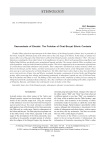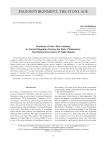Archaeology, Ethnology & Anthropology of Eurasia @journal-aeae-en
Статьи журнала - Archaeology, Ethnology & Anthropology of Eurasia
Все статьи: 524

Статья научная
This dental study addresses the origin of the Bolshaya Rechka people in the Novosibirsk region of the Ob, with reference to the migration of Saka and Sarmatian tribes from the southwest. I compare dental features of southern Kamen and northern Bolshaya Rechka populations inhabiting the entire Upper Ob area. Dental samples from eleven Bolshaya Rechka cemeteries were studied. Findings indicate heterogeneity. Nearly all samples evidence admixture between eastern and western groups. That from Bystrovka-3 takes a separate position, revealing more eastern traits along with those marking the Southern Siberian Upper Paleolithic complex. The results enable us to evaluate the role of Saka and Sarmatian migrants from Kazakhstan, Cis-Urals, and Tian Shan. This role appears to have been relatively minor and likely indirect, upholding the ideas advanced by archaeologists. Bolshaya Rechka and Kamen populations (the latter culture was thought to include the former) are biologically distinct. Bolshaya Rechka displays continuity with local Early Bronze Age groups. The main component of the Kamen population of forest-steppe Altai, on the other hand, was introduced by Saka and Sarmatian immigrants, who, evidently, had not reached the Novosibirsk region of the Ob. Rather than moving on northwards along the Ob from the forest-steppe Altai, they turned west, toward the Tobol-Irtysh watershed.
Бесплатно

Descendants of eleudei: the problem of oirat-buryat ethnic contacts
Статья
Eleuths (Ölöts) played an important part in the ethnic history of the Mongol peoples of Inner Asia, in particular of the Oirats, being the dominant group of the Oirat union at the early stages of its history. In this study, an attempt was made to fi ll in one of the gaps in the ethnic history of the Turko-Mongol peoples, using the ethnonym “Ölöt”. The major limitation in studying the Oirat ethnic history is the insuffi ciency of sources. Much can be gained from using Buryat and Sakha (Yakut) folklore, specifi cally epics, genealogical legends, and tales. The reason is that the Ölöts, according to one of the hypotheses, took part in the formation of those peoples. This idea is supported by the reconstruction of protoforms of certain Buryat and Yakut ethnonyms and eponyms. Their comparative and historical analysis indicates ethnic ties between the Buryats and the Yakuts, and their participation in the ethnic history of the Mongolian stratum. These facts open up a wider perspective on Turko-Mongol ties. The Ölöt ethnic history shows them to have been distributed across vast territories of Inner Asia and Siberia, eventually becoming a component of various Turkic and Mongolian groups, while preserving their identity and featuring prominently in ethnogonic legends not only of Dörben-Oirats, but of the Buryats and Yakuts as well. The fi ndings of this study attest to the complexity of ethnic processes among the Mongolian and Turkic speaking nomads of Eurasia. Also, they contribute to the understanding of the ethnic composition of Mongolia, Buryatia, and Yakutia, thus widening the scope of studies on the Altai.
Бесплатно

Early Upper Paleolithic Tubular Beads from the Main Chamber of Denisova Cave
Статья научная
The authors present the results of a technological and functional analysis of bone tubular beads from the Upper Paleolithic layer 11 in the Main Chamber of Denisova Cave, northwestern Altai. Tubular beads are among the most widespread categories of Early Upper Paleolithic ornaments from the cave. The technological sequence of operations has been reconstructed. It included several stages: selection of blank, planing, manufacture of preform by truncating the epiphyses, ornamenting the preform, marking preforms for fracturing into short tubes, sawing or cutting, fragmentation by cuts, removal of cancellous bone, and smoothing the fracture surfaces. Prepared blanks and diagnostic production waste were not noted in the technological context of the complex; this indicates that the tubular beads were probably manufactured outside the excavated area of the Main Chamber. The analyses revealed traces of wear caused by contact with clothing or human skin and by threading on a string or thin strap. Tubular beads were used by the Upper Paleolithic inhabitants of the cave as elements of clothing, necklaces, and probably bracelets. The closest but still considerably distant parallels to the tubular beads from the Altai are Aurignacian ornaments of a similar age from Western, Central, and Eastern Europe.
Бесплатно

Early Upper Paleolithic serpentine ornaments from Ust-Karakol, Northwestern Altai
Статья обзорная
Бесплатно

Early medieval jeweler's kit from the Western Amur region
Статья научная
A late 9th century jeweler's kit from dwelling 2 at Osinovoye Ozero, a Mohe site on the Middle Amur, is described. Bronze was smelted in a crucible placed on a ceramic support inside a vessel-like furnace. Nine bronze plaques from the same dwelling are compared with negatives of molds in which they were cast. Based on results of the elemental analysis of plaques, these fall into three groups. The fi rst differs from the other two by the source of ore, and plaques of the second group were recast more than once. Most Turkic type plaques were evidently destined for recasting into Mohe ornaments. The latter include one openwork and two fi gured plaques as well as bronze bells found in 2012 in dwelling 3. Because bronze items differing in composition were recast several times, the source of ore cannot be identifi ed. Techniques of manufacturing molds and facing of plaques, used by Central Asian and Mohe artisans, are reconstructed.
Бесплатно

Early middle paleolithic industries in southeastern dagestan
Статья
This study addresses lithic assemblages from the Middle Paleolithic sites Darvagchay-Zaliv-1 and Darvagchay- Zaliv-4, which are highly relevant to the understanding of this stage in Dagestan. We examine paleoclimatic conditions prevailing during the sedimentation at these sites. A detailed description of lithics is provided. Artifacts were discovered in a minimally disturbed paleosol. They represent the Middle Paleolithic, specifi cally Levallois technique of primary reduction. Judging by the presence of unlined fi re-pits and the fact that fi nds are scattered over a large area, we infer that these sites evidence multiple short-term occupation. The dates of the sites fall within the Riss-Würm (Eemian, Mikulino) interstadial (MIS 5e)—ca 125–110 ka BP. Parallels with coeval sites in Dagestan and elsewhere in the Caucasus are discussed. Whereas no direct parallels with any Caucasian Middle Paleolithic industries can be found, those of Darvagchay-Zaliv-1 and Darvagchay-Zaliv-4 are consistent with the general evolutionary trajectory of the Caucasian Paleolithic.
Бесплатно

Early-middle Acheulean occupation of the Northern Transcaucasian highland
Статья научная
In the northern part of the Transcaucasian Highland (Lori Depression, Armenia), three stratifi ed sites dating to the Early-Middle Acheulean—Karakhach, Kurtan I, and Muradovo—have long been subject to archaeological studies. On the basis of absolute dates and paleomagnetic records relating to the fi rst two sites, their age falls in the interval between the mid-Early and initial Middle Pleistocene. All three sites yielded a uniform industry with a peculiar toolset (various choppers, picks including chisel-ended ones, handaxes, large scrapers, macro-chisels, and macro-knives), manufactured mostly on natural tabular fragments of local volcanic rocks. Certain indicators of this industry, such as subrectangular and fan-shaped choppers, slab-like chisels, etc., are described. Information on 28 other localities with Acheulean artifacts, including 11 stratifi ed ones, recently discovered in various parts of the Lori Depression and in adjacent areas of the Shirak Depression and the Debed River valley, is provided. It is demonstrated that the lithics from all these sites belong to the Karakhach tradition. Data are cited suggesting that three sites (Yagdan, Agvi-canyon, and Agvorik) are over 2 mln years old, and two more (Kurtan II and Dzhradzor) are at least 1.5 mln years old. It is concluded that people associated with the Karakhach Acheulean tradition had appeared in the northern Transcaucasian Highland ~2.0 Ma BP, then settled widely in this area, and remained there for several hundred thousand years. In my view, this may be explained by the very favorable environmental conditions of the region during the Early Pleistocene, and by the abundance of large rock fragments suitable for tool manufacture.
Бесплатно

Статья научная
An attempt is made to classify, analyze, and interpret female burials with weapons in the graves of early nomads in the Southern Urals, dating to late 5th–2nd centuries BC. In the Early Iron Age, this vast region was a center of the nomadic elite. The sample includes 23 graves with 24 buried individuals at well documented cemeteries. Only individuals for whom skeletal sex indicators are available have been included. Criteria and opinions are revised. Weapons in female burials include mostly quiver sets; whereas daggers, swords, and spearheads are rare. The placement of weapons was the same as in male burials: bladed weapons were placed on the right side, with hilts directed to the right hand, whereas quivers were found mostly on the left side. The remaining funerary items were exactly like in other female burials: there were numerous ornaments, bronze mirrors, spindle whorls, and stone altars. Female burials with weapons were found in kurgans regardless of social status. Apparently, those women represented all social strata, from elite to low-ranking nomads. Nothing indicates the existence of female military units, which, however, does not imply that women took no part in armed confl icts or did not use weapons to protect themselves and their homes.
Бесплатно

Findings from the Paleolithic studies in Siberia
Статья научная
It was long believed that Siberia with its harsh environment and climate had been peopled by humans rather late, and that the culture of early Siberian hominins was primitive. Wide-ranging discoveries of the last 3–4 decades, carried out by archaeologists of Siberia, especially those from the Institute of Archaeology and Ethnography SB RAS in Novosibirsk, with the participation of experts in other disciplines such as geology, geochronology, paleontology, paleobotany, genetics, etc., indicate very early dates of the initial peopling of Siberia and a new taxon, H. s. altaiensis, which is associated with one of the most interesting cultures in Eurasia and, along with the earliest anatomically modern African humans, H. s. neanderthaliensis, and H. s. orientalensis, had participated in the origins of anatomically modern H. s. sapiens.
Бесплатно

Статья научная
The northeastern Iranian Plateau is considered a leading region in Paleolithic studies. The history of Paleolithic research in this region dates back to the mid-20th century. However, unlike the western and, to some extent, the central part of the Iranian Plateau, only a handful of sites have been identifi ed in the northeastern part. Field studies conducted on the Neyshabur plain have provided some of the only Paleolithic evidence at four locations in the foothills of the Binalud Mountains: Dar Behesht, Mushan Tappeh, Ali Abad, and Qezel Tappeh. Our research aims to assess this evidence, provide a revised typology of Pleistocene artifacts from the Neyshabur plain, and also study the role of these and other fi nds in the area and analyze their signifi cance in terms of the dispersal of Pleistocene hominin populations. We propose two main corridors on the northeastern Iranian Plateau assumed to have been infl uential in the dispersal of human ancestors.
Бесплатно











